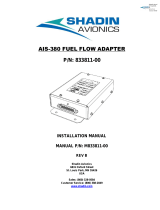
500W Series 190-01226-03 Rev. 5
Instructions for Continued Airworthiness Bell 206B Page 13 of 23
2.6.1 500W Series Alerts
The 500W Series will display a number of alerts. These are listed in the following table.
Table 3. 500W Series Alert Troubleshooting Guide
Alert Text Possible Cause Solution
ADS-B traffic has failed
The ADS-B traffic system may have
lost GPS position or detected an
internal fault.
Check the applicable ADS-B
traffic source status page in
Aux mode
Contact Garmin technical
support.
ADS-B transmit has
failed
ADS-B unit is not able to transmit a
message due to a failure with the
ADS-B system or antenna(s).
Check system and antenna
wiring. If problem persists
contact Garmin technical
support.
ADS-B is not
transmitting position
The ADS-B unit has detected a
position input fault.
Verify GPS position source is
functional. If problem persists
contact Garmin technical
support.
ADS-B fault - Check
ADS-B Status Page
An equipment fault has been detected.
Contact Garmin technical
support.
ADS-B - Connection
has been lost
The GNS is configured for a traffic
device but is not receiving data from it.
Traffic will not be displayed on the
GNS.
Verify traffic system is
configured correctly. If
problem persists contact
Garmin technical support.
ADS-B Traffic Alerting
not available
The ADS-B traffic system is reporting
that the CSA application has failed.
Traffic alerting on ADS-B traffic is
unavailable.
Ensure the aircraft has a clear
view of the sky. If problem
persists contact Garmin
technical support.
Airport terrain database
integrity error
The 500W Series unit has detected a
problem with a database on the
Terrain data card. The message
“<database name> database integrity
error” indicates the data base in error.
The data is not usable, try
reloading the information onto
the card. If that does not
solve the problem replace the
card.
Audio database error
out of date or missing
The 500W-series unit has detected a
problem with the built-in HTAWS
Audio Data-base. HTAWS audio
alerts are not available.
Contact Garmin technical
support.
Aviation database
integrity error
The 500W Series unit has detected a
problem with a database on the
NavData® card. The message
“<database name> database integrity
error” indicates the data base in error.
The data is not usable, try
reloading the information onto
the card. If that does not
solve the problem replace the
card.
Basemap database
integrity error
The 500W Series unit has detected a
failure in the built-in basemap (land
data) database. Land data does not
appear on the Map Page. Other unit
functions continue to work normally.
Reload the Basemap
database
Boot block verify failed -
Return unit for repair
System integrity testing has
determined that the boot block has
become corrupted.
Contact Garmin technical
support.





















